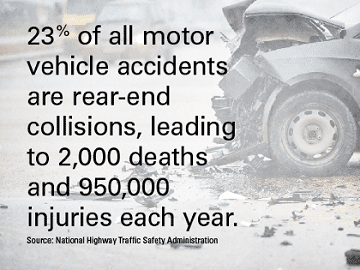- Home
- Loss Control
- Loss Control Insights
- 5 Ways to Stop Tailgating
Tailgating (following too closely behind the vehicle in front of you) may be caused by road rage, inattention to surroundings, hurrying or distractions. Whatever the cause, the results can be messy and lead to rear-end collisions. The National Highway Traffic Safety Administration claims that between 2012 and 2014, nearly half of all 2-vehicle crashes were rear-enders, killing more than 1,700 people each year. These accidents are often preventable. If drivers leave sufficient space between their car and the one ahead of them, they’ll have time to stop before a crash happens.
How much space between vehicles is enough? The National Safety Council’s defensive driving courses focus on the “3-second rule.” This rule is a simple way to check that you are driving at a safe distance. Begin counting to 3 when the car ahead of you passes a fixed marker—a tree or a road sign, for example. If you reach the same fixed point before you count to 3, you are following too close. Increase your distance in bad weather or slippery road conditions, or if your vehicle requires more stopping time. (hauling a load, pulling a trailer, etc.)
Many drivers don’t realize that stopping distance is different for vehicles of different sizes and weights. For example, it takes about twice the distance to stop a heavy truck than it does a car. These factors must be taken into account when adjusting the 3-second rule.
Action Steps for a Safer Fleet
You probably have employees driving your vehicles who tailgate. In a Michelin survey, 74% of drivers surveyed claimed they were tailgated in the previous 6 months, but only 11% admitted they had tailgated in that same time frame. Following closely is a habit of many drivers, and they may not even realize they are guilty of the practice.
You can’t ride along with each of your employees every day to ensure they are safe drivers, so what can you do?
- Test potential employees before you hire them. Do a ride-along with job candidates as part of the interview process. If you notice a bad behavior, such as tailgating, that may be reason enough for not hiring the person.
- After hiring, periodically ride along with drivers to ensure that they maintain good driving habits, including the 3-second rule.
- Include tailgating reminders in any driving safety training programs you offer.
- Make sure your company driving policies and procedures don’t force drivers to rush from one stop to the next. Pressure to perform on tight deadlines may cause a culture of poor driving habits, including tailgating.
- As you purchase vehicles, opt for those with safety features that help prevent rear-end crashes.
Vehicle Safety Features to Prevent Tailgating and Crashes
Certain vehicle technologies can take action much quicker than a driver can react. These features can be lifesavers, preventing or reducing the severity of rear-end crashes caused by tailgating. They may also train your drivers on correct following distances.
- Automatic emergency braking (AEB) senses cars ahead and applies the brakes hard to slow or stop the vehicle rapidly. While AEB can’t always prevent a crash, it can lessen the severity. AEB is often paired with forward collision warning.
- Forward collision warning lets the driver know that a crash is coming. If the driver doesn’t react quickly enough, AEB takes over to slow or stop the vehicle.
- Adaptive cruise control automatically speeds up or slows down the car to keep a safe following distance from the car ahead. Drivers have the ability to set the gap―or following distance―to short, medium or long.
Find out more about these safety features and view videos demonstrating how they work at mycardoeswhat.org.
Get in touch
Need help? We’re here for you! Whether you have questions or need personalized assistance, your local office is ready to support you.
Loss Control Insights
Stay informed with the latest news and receive actionable safety tips, all carefully curated by our team of experts.
